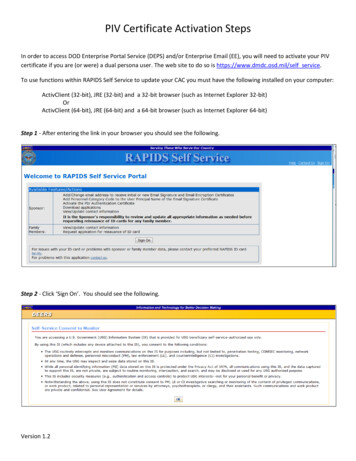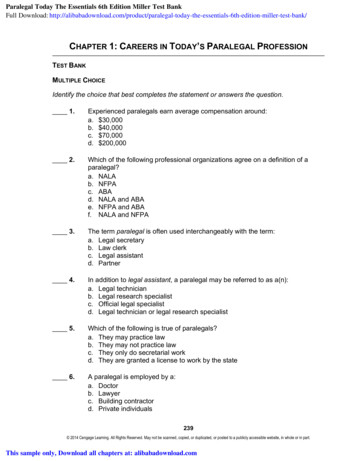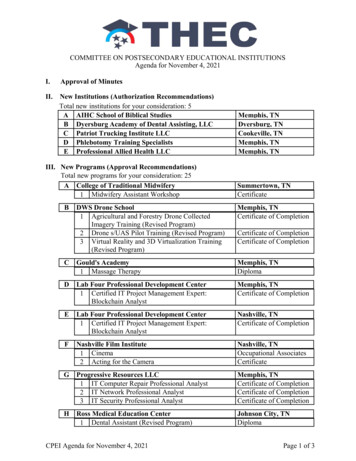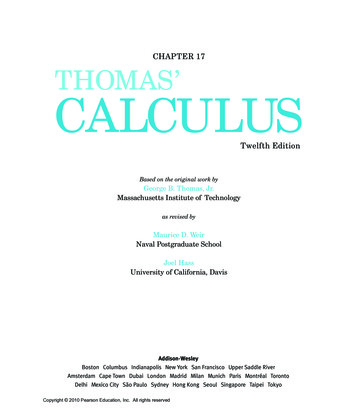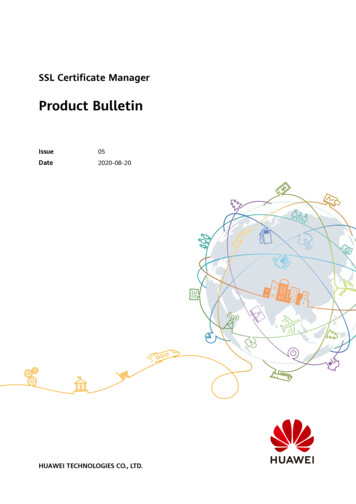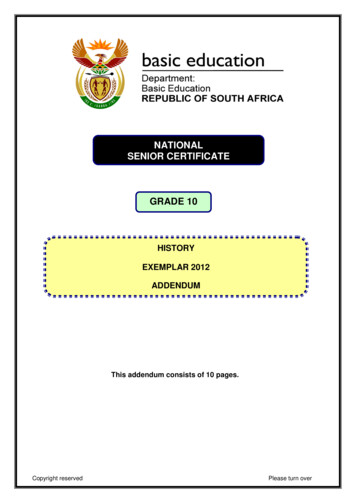
Transcription
GRAAD 12NATIONALSENIOR CERTIFICATEGRADE 10HISTORYEXEMPLAR 2012ADDENDUMThis addendum consists of 10 pages.Copyright reservedPlease turn over
HistoryQUESTION 1:2NSC – Grade 10 Exemplar – AddendumDBE/2012WHAT FACTORS CONTRIBUTED TO THE OUTBREAK OF THEFRENCH REVOLUTION IN 1789?SOURCE 1AThis extract focuses on King Louis XVI's rule of France. He handed out an arrestwarrant to anybody who opposed his reign between 1775 and 1792.People at the time were not happy with the fact that France was an absolutemonarchy. The king had power over everything, whatever he said had to be done wasdone whenever he wanted it to be done. Many claimed that King Louis XVI abused hispower and that he was a tyrant. One major thing that made the French people angrywas his use of 'sealed letters' known as 'lettres de cachet' to the French. These letterswere letters of execution or imprisonment. The king would sign his name on the paperand send the letters to his ministers, who could fill in any name that they wanted.These letters made the people feel insecure of their lives, even if they had donenothing wrong they always had to fear that a minister would not get along with themand then they may receive a letter. During King Louis XVI's time of power around14 000 of these letters were issued among his people. People were angry that the Kinghad complete power over them and their families, but they were also angry about thelaws that the whole government had issued. Taxes were issued according to socialclass, and privileges like voting and even freedom of speech depended on a person'sstatus. Overall the French were upset with their whole political system.[From: ent work/rachelle.htm]SOURCE 1BThis table shows the French monarchy's income and expenditure during 1786, fouryears before the French Revolution.INCOMERoyal lands and forestsDonationsDirect taxesIndirect taxesRoyal monopoliesEXPENDITURERoyal householdForeign affairsArmyNavyPublic worksCharitySalaries and pensionsInterest payments on debtsCost and expensesOther51,2 million livres*20,6 million livres163 million livres219 million livres17,5 million livresTOTAL: 471,3 MILLION LIVRES42 million livres14,4 million livres107 million livres51,8 million livres14,9 million livres19 million livres47,8 million livres261 million livres65,4 million livres9,6 million livresTOTAL: 622,9 MILLION LIVRES*livres – French money[From: The French Revolution by P Mantin]Copyright reservedPlease turn over
History3NSC – Grade 10 Exemplar – AddendumDBE/2012SOURCE 1CThis extract focuses on the experience of a French peasant woman in 1789. Ithighlights her family's suffering because of the payment of taxes to the landlords.Walking up a long hill to ease my horse, I was joined by a poor woman, whocomplained of the times, and that it was a sad country. She said her husband had buta bit of land, one cow, and a poor little horse yet they had about 20 kg of wheat andthree chickens to pay as feudal dues to one lord, and about 75 kg of oats, one chicken,and one franc, to pay to another, besides very heavy tailles and other taxes. She hadseven children, and the cow's milk helped to make the soup It was said, at present,that something was to be done by some great people for such poor ones, but she didnot know who nor how, but may God send us better, she said, because the tailles andthe feudal dues are crushing us.This woman, at no great distance, might have been taken for sixty or seventy, herfigure was so bent and her face so lined and hardened by labour, but she said she wasonly twenty-eight.[From: Travels in France during the Years 1787, 1788, and 1789 by Arthur Young]Copyright reservedPlease turn over
History4NSC – Grade 10 Exemplar – AddendumDBE/2012SOURCE 1DThis cartoon depicts a peasant carrying the burdens (weight) of the monarchy on hisshoulders. The nobility, on the left-hand side of the cartoon, increases the burden.The priest on the right-hand side of the cartoon, who represents the clergy, is seenreluctantly trying to assist the peasant with his burdens.[From: Timelines 8 by H Lintvelt et al]TRANSLATION OF WORDS AROUND THE CARTOON:Explanation of the image – The third estate carries all the weight of the monarchy, thenoble presses on it to increase the weight and the priest seems to help him merely withone finger.Copyright reservedPlease turn over
HistoryQUESTION 2:5NSC – Grade 10 Exemplar – AddendumDBE/2012WHAT ROLE DID KING SHAKA PLAY IN THE FORMATION OFTHE ZULU KINGDOM?SOURCE 2AThis source focuses on one of the reasons for the Mfecane (Difaqane). It gives atraditional view of King Shaka as the leader of the Zulus.In the nineteenth century, a young Zulu warrior, Shaka, began consolidating his uncleDingiswayo's Mthethwa chieftainship and built a formidable army, with which he foughtand destroyed the rival Ndwandwe group. He then took over the reins of the AmaZulugroup after the death of his father, Senzangkhona, and combined the threechieftainships into one group, later called the Zulu kingdom Tales abound of his cruelty and tyranny [dictatorship]. For example, after his motherNandi's death, he exterminated [murdered] many of his own people as a sign ofmourning – although historians do argue that it was a way to get rid of politicalopponents, rather than a sign of grief.Shaka's army, which grew to encompass [include] 40 000 men, began a campaign ofincorporating other independent chieftainships in the area, pillaging [raiding] grain andcattle as they went. Many were conquered, some in bloodless campaigns, but othersfought off their invaders. Where they failed, some – like Mzilakazi's people – decided toflee rather than being conquered by the AmaZulu. They fled northwards across theLimpopo River, and settled in what is today south-western Zimbabwe. They becameknown as the AmaNdebele. This was referred to as the Mfecane.[From: History Grade Ten by E Maloka et al.]SOURCE 2BThe following account is D Wylie's view of King Shaka.A few things I think we can safely say Shaka was not. He was not a pathological[uncontrolled] mass murderer. He did not slaughter large numbers of cowards; he didnot order the wholesale killing of women, children and dogs; he did not hurl people offthe cliffs at Shaka's Rock or anywhere else; he did not obliterate [destroy] the Langenior any other group. He did not kill his own mother. I am not trying to whitewash Shaka.Not even his admirers said he was warm and cuddly [loveable]. He could hardly havebecome the regional leader he was, had he not been uncompromisingly [inflexible]tough, wily [shrewd] and adept [skilful]. As with governments everywhere, his edicts[laws] were in the last resort enforced, sometimes by brutal and fatal methods. (InEngland at the same time, a man could be hanged at Newgate for stealing a loaf ofbread.) He had people executed. He was expected to .There is, however, little evidence that his acts disregarded traditional law altogether. Itseems much more likely that at least most of the killings which the whites observed (asopposed to the massacres they claimed happened but did not observe) were done fortraditional sanctioned political or judicial ends.[From: Shaka, A Jacana Pocket Biography Sunnyside by D Wylie]Copyright reservedPlease turn over
History6NSC – Grade 10 Exemplar – AddendumDBE/2012SOURCE 2CThis extract focuses on the results of the Mfecane.The Mfecane, as it became known, both united and divided the northern Ngunipopulation of Natal. On the one hand it was responsible for the drawing of clan afterclan into the fledgling Zulu state. On the other hand it sent thousands who refused toaccept subjugation into desperate flight to other regions of Southern Africa.Shaka's new kingdom was built on strict discipline which united hundreds of diversecommunities behind the central authority of the king. Although he ruled like a despot,an inner circle of chiefs advised him on matters of national importance and acted as acheck on possible abuses of power. A second tier of indunas [minor chiefs] ensuredthat the orders of the king and his 'cabinet' were carried out. They also assisted inmatters such as the allotment of land, the settling of minor disputes and the distributionof cattle No one owned property in Shaka's Zululand. Land belonged to everyone,and was there to be exploited for the mutual benefit of all .[From: Reader's Digest Illustrated History of South Africa, Cape Town]Copyright reservedPlease turn over
HistoryQUESTION 3:7NSC – Grade 10 Exemplar – AddendumDBE/2012WHAT WAS THE IMPACT OF THE 1913 NATIVES LAND ACT ONBLACK SOUTH AFRICANS?SOURCE 3AThis source comments on the impact of 1913 Natives Land Act on Black SouthAfricans.The first major test for the new organisation (The South African Native NationalCongress, established in 1912) soon presented itself. Building on earlier ideas ofsegregation the Union government embarked on a policy of territorial segregation,laying aside land for the exclusive use of whites and blacks (the latter being restrictedto less than ten per cent of the country) – through the Natives Land Act (1913).Thousands of families of tenant farmers were forced off white-owned land, either intothe 'scheduled areas' or into towns. In the famous words of Solomon Plaatje, one ofthe founders of the ANC: 'Awaking on Friday morning, 20 June 1913, the South Africannative found himself, not actually a slave, but a pariah (social outcast) in the land of hisbirth.'[From: Nelson Mandela and the rise of the ANC by J Schadeberg]SOURCE 3BThis source explains the impact that the implementation of the 1913 Natives Land Acthad on Maria. The story was a result of several interviews that were undertaken by SolPlaatje after the 1913 Natives Land Act was passed.Among the squatters on the same farm as Kgabale was a widow named Maria. Herhusband in his life-time had lived as a tenant on the farm, ploughing in shares until hisdeath. After his death Maria kept on the contract and made a fair living. Her son anddaughter, aged fourteen and sixteen respectively, took turns at herding cattle andassisting the mother in other ways. for Maria, being a widow, and her son being but a youth, it was hoped that thelandlord would propose reasonable terms for her; but instead his proposal was that sheshould dispose of her stock and indenture her children to him. Maria found it difficult tocomply with her landlord's demand. the landlord then is said to have set fire toMaria's thatched cottage, and Maria, with her bedclothes on her head, and on theheads of her son and daughter, and carrying her three-year-old boy tied to her back,walked off from the farm, driving her cows before her. In parting from their latehome, for one blank and unknown, the children were weeping bitterly.[From: Native Life in South Africa by Sol T Plaatje]Copyright reservedPlease turn over
History8NSC – Grade 10 Exemplar – AddendumDBE/2012SOURCE 3CThis source is an extract from a farmer, Mr V. His real name was not revealed becausehe would have faced prosecution from the authorities. He informed his workers aboutthe decision he took to reverse the implementation of the 1913 Natives Land Act on hisfarm.Mr. V, the farmer, mounted a handy wagon and commenced to address the crowdof blacks who gathered around the wagon 'Attention! Listen,' he said. 'You will remember that I was here last month andexplained to you the new law. Well, I understand that the explanation created thegreatest amount of unrest among the natives in the huts on my farm. Personally, I amvery sorry that it ever came to that, but let me tell you that your Nooi, my wife, says it isnot right that the terms under which we have lived in the past should be disturbed.I agree with her that it is unjust, and that the good Lord, who has always blessed us,will turn His face from us if people are unsettled and sent away from the farm in adiscontented move.' (Loud and continued applause )'The Nooi, says we must not obey the law: she even says, if it comes to physicalejectment, or if they take me to prison, she is prepared to go to Pretoria in person andinterview General Botha.' (More cheers, during which the natives dispersed to cartaway their mealies amidst general satisfaction.)[From: Native Life in South Africa by Sol T Plaatje]Copyright reservedPlease turn over
History9NSC – Grade 10 Exemplar – AddendumDBE/2012SOURCE 3DThis photograph shows the delegation that was sent to Britain in 1914 by the SouthAfrican Native National Congress (SANNC). The intention of the delegation was tovoice its disapproval of the 1913 Natives Land Act.A delegation of members of the newly formed SANNC that was sent to Britain in 1914.In the front row (seated from left to right): Thomas Mtobi Mapikela, John LangalibaleleDube (first president), Solomon Tshekisho Plaatje (first secretary-general). Standingfrom left to right are: Walter Benson Rubusana and Saul Msane.[From: Turning Points in History, Book 4, Industrialisation, Rural Change and Nationalism]Copyright reservedPlease turn over
History10NSC – Grade 10 Exemplar – AddendumDBE/2012ACKNOWLEDGEMENTSVisual sources and other historical evidence were taken from the following:1.2.3.4.5.6.7.8.9.10.Du Toit F. Ed. 2004. Turning Points in History, Book 4, Industrialisation, RuralChange and Nationalism (STE Publishers Pty student work/rachelle.htmLintvelt H et al. 1985. Timelines 8 (Maskew Miller Longman, Cape Town)Maloka E et al. 2004. History Grade Ten (Nasou/Via Africa)Mantin P. 2002. The French Revolution (Heinemann Educational Publishers,Oxford)Plaatje ST. 1998. Native Life in South Africa (Gutenberg)Reader's Digest Illustrated History of South Africa. 1995. (Reader's Digest,Cape Town)Schadeberg J. 1990. Nelson Mandela and the rise of the ANC (Jonathan Ball)Wylie D. 2011. Shaka, A Jacana Pocket Biography (Ultra Litho Pty Ltd)Young A. 1906. Robinson JH. Ed. Travels in France during the Years 1787,1788, and 1789 (Ginn, Boston)Copyright reserved
power and that he was a tyrant. One major thing that made the French people angry was his use of 'sealed letters' known as 'lettres de cachet' to the French. These letters were letters of execution or imprisonment. The king would sign his name on the paper and send the letters to his ministers, who could fill in any name that they wanted.
